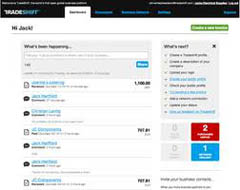ScienceDaily (Oct. 30, 2012) ? Habits are behaviors wired so deeply in our brains that we perform them automatically. This allows you to follow the same route to work every day without thinking about it, liberating your brain to ponder other things, such as what to make for dinner.
However, the brain's executive command center does not completely relinquish control of habitual behavior. A new study from MIT neuroscientists has found that a small region of the brain's prefrontal cortex, where most thought and planning occurs, is responsible for moment-by-moment control of which habits are switched on at a given time.
"We've always thought -- and I still do -- that the value of a habit is you don't have to think about it. It frees up your brain to do other things," says Institute Professor Ann Graybiel, a member of the McGovern Institute for Brain Research at MIT. "However, it doesn't free up all of it. There's some piece of your cortex that's still devoted to that control."
The new study offers hope for those trying to kick bad habits, says Graybiel, senior author of the new study, which appears this week in the Proceedings of the National Academy of Sciences. It shows that though habits may be deeply ingrained, the brain's planning centers can shut them off. It also raises the possibility of intervening in that brain region to treat people who suffer from disorders involving overly habitual behavior, such as obsessive-compulsive disorder.
Lead author of the paper is Kyle Smith, a McGovern Institute research scientist. Other authors are recent MIT graduate Arti Virkud and Karl Deisseroth, a professor of psychiatry and behavioral sciences at Stanford University.
Old habits die hard
Habits often become so ingrained that we keep doing them even though we're no longer benefiting from them. The MIT team experimentally simulated this situation with rats trained to run a T-shaped maze. As the rats approached the decision point, they heard a tone indicating whether they should turn left or right. When they chose correctly, they received a reward -- chocolate milk (for turning left) or sugar water (for turning right).
To show that the behavior was habitual, the researchers eventually stopped giving the trained rats any rewards, and found that they continued running the maze correctly. The researchers then went a step further, offering the rats chocolate milk in their cages but mixing it with lithium chloride, which causes light nausea. The rats still continued to run left when cued to do so, although they stopped drinking the chocolate milk.
Once they had shown that the habit was fully ingrained, the researchers wanted to see if they could break it by interfering with a part of the prefrontal cortex known as the infralimbic (IL) cortex. Although the neural pathways that encode habitual behavior appear to be located in deep brain structures known as the basal ganglia, it has been shown that the IL cortex is also necessary for such behaviors to develop.
Using optogenetics, a technique that allows researchers to inhibit specific cells with light, the researchers turned off IL cortex activity for several seconds as the rats approached the point in the maze where they had to decide which way to turn.
Almost instantly, the rats dropped the habit of running to the left (the side with the now-distasteful reward). This suggests that turning off the IL cortex switches the rats' brains from an "automatic, reflexive mode to a mode that's more cognitive or engaged in the goal -- processing what exactly it is that they're running for," Smith says.
Once broken of the habit of running left, the rats soon formed a new habit, running to the right side every time, even when cued to run left. The researchers showed that they could break this new habit by once again inhibiting the IL cortex with light. To their surprise, they found that these rats immediately regained their original habit of running left when cued to do so.
"This habit was never really forgotten," Smith says. "It's lurking there somewhere, and we've unmasked it by turning off the new one that had been overwritten."
Online control
The findings suggest that the IL cortex is responsible for determining, moment-by-moment, which habitual behaviors will be expressed. "To us, what's really stunning is that habit representation still must be totally intact and retrievable in an instant, and there's an online monitoring system controlling that," Graybiel says.
The study also raises interesting ideas concerning how automatic habitual behaviors really are, says Jane Taylor, a professor of psychiatry and psychology at Yale University. "We've always thought of habits as being inflexible, but this suggests you can have flexible habits, in some sense," says Taylor, who was not part of the research team.
It also appears that the IL cortex favors new habits over old ones, consistent with previous studies showing that when habits are broken they are not forgotten, but replaced with new ones.
Although it would be too invasive to use optogenetic interventions to break habits in humans, Graybiel says it is possible the technology will evolve to the point where it might be a feasible option for treating disorders involving overly repetitive or addictive behavior.
In follow-up studies, the researchers are trying to pinpoint exactly when during a maze run the IL cortex selects the appropriate habit. They are also planning to specifically inhibit different cell types within the IL cortex, to see which ones are most involved in habit control.
The research was funded by the National Institutes of Health, the Stanley H. and Sheila G. Sydney Fund, R. Pourian and Julia Madadi, the Defense Advanced Research Projects Agency, and the Gatsby Foundation.
Share this story on Facebook, Twitter, and Google:
Other social bookmarking and sharing tools:
Story Source:
The above story is reprinted from materials provided by Massachusetts Institute of Technology. The original article was written by Anne Trafton.
Note: Materials may be edited for content and length. For further information, please contact the source cited above.
Journal Reference:
- K. S. Smith, A. Virkud, K. Deisseroth, A. M. Graybiel. Reversible online control of habitual behavior by optogenetic perturbation of medial prefrontal cortex. Proceedings of the National Academy of Sciences, 2012; DOI: 10.1073/pnas.1216264109
Note: If no author is given, the source is cited instead.
Disclaimer: This article is not intended to provide medical advice, diagnosis or treatment. Views expressed here do not necessarily reflect those of ScienceDaily or its staff.
Source: http://feeds.sciencedaily.com/~r/sciencedaily/most_popular/~3/qazGk3MFov4/121031111425.htm
carmen whitney houston last performance cpac straw poll breaking dawn part 2 breaking dawn part 2 whitney cummings i will always love you
 The major up and coming startup companies in Europe will be the driving force supporting the region?s financial upturn.
The major up and coming startup companies in Europe will be the driving force supporting the region?s financial upturn. Founded in 2007 by Alex Ljung, Soundcloud is a sound-platform that permits anyone to grab, create, and share sounds throughout the web, somewhat like YouTube but strictly focusing on sound. With more than 8 million users, they broadcast their partnership with Song Kick & Foursquare,?winning the media and audio classification of the telegraph-start-up 100 prize. This year of 2012 is said to be an even bigger year for the company.
Founded in 2007 by Alex Ljung, Soundcloud is a sound-platform that permits anyone to grab, create, and share sounds throughout the web, somewhat like YouTube but strictly focusing on sound. With more than 8 million users, they broadcast their partnership with Song Kick & Foursquare,?winning the media and audio classification of the telegraph-start-up 100 prize. This year of 2012 is said to be an even bigger year for the company. Tradeshift was Founded in 2009, and introduced in 2010 by?Christian Lanng, Mikkel Hippe Brun and Gert Sylvest.
Tradeshift was Founded in 2009, and introduced in 2010 by?Christian Lanng, Mikkel Hippe Brun and Gert Sylvest. iZettle, which is?founded by Magnus Nilsson & Jacob De Geer allows anyone to make card payments anyplace, anytime, anywhere with the use of an iPhone-app and mini-chip card-reader that can be linked to a phone. Founded in 2010 in beta form, the company has successfully raised ?11.2 million.
iZettle, which is?founded by Magnus Nilsson & Jacob De Geer allows anyone to make card payments anyplace, anytime, anywhere with the use of an iPhone-app and mini-chip card-reader that can be linked to a phone. Founded in 2010 in beta form, the company has successfully raised ?11.2 million. Started by Pardeep Kullar & Steve Lai, This Web and mobile app assists individuals to find people with similar interests while they are out on the town. Users can choose the kind of individuals they would prefer to meet in various categories like hobbies, spontaneous dates, and students. Anything that brings the right people closer must be good right? Join LikeOurselves today.
Started by Pardeep Kullar & Steve Lai, This Web and mobile app assists individuals to find people with similar interests while they are out on the town. Users can choose the kind of individuals they would prefer to meet in various categories like hobbies, spontaneous dates, and students. Anything that brings the right people closer must be good right? Join LikeOurselves today. House Trip was introduced in 2010 by Arnaud Bertrand and Junjun Chen. It is an apartment hunting Internet website were any person can reserve a villa or apartment, and property-owners can also place their accommodations on the site. They have recently expanded beyond London, Berlin, and Paris, making their way around the whole of Europe and a growing number of countries around the globe, with nearly 60,000 properties listed.
House Trip was introduced in 2010 by Arnaud Bertrand and Junjun Chen. It is an apartment hunting Internet website were any person can reserve a villa or apartment, and property-owners can also place their accommodations on the site. They have recently expanded beyond London, Berlin, and Paris, making their way around the whole of Europe and a growing number of countries around the globe, with nearly 60,000 properties listed. Radionomy permits individuals to develop and listen-to radio stations on the web gratis, while sharing a tailored radio-show complete with jingles, music programming, and commercials, with bespoke pod casts and reports to share with friends, family, and strangers around the world community. The company has expanded quickly in 2011 since its creation?by?Van Kan Cedric,?Baudechon Yves,?Alexandre Saboudijan?and?Bindets Gilles?back in 2008.
Radionomy permits individuals to develop and listen-to radio stations on the web gratis, while sharing a tailored radio-show complete with jingles, music programming, and commercials, with bespoke pod casts and reports to share with friends, family, and strangers around the world community. The company has expanded quickly in 2011 since its creation?by?Van Kan Cedric,?Baudechon Yves,?Alexandre Saboudijan?and?Bindets Gilles?back in 2008. This German start-up is a multi-platform efficiency solutions company for businesses, groups, and individuals. Founded by Serial Entrepreneur Christian Reber.?The company?s main product Wunderlist task-management software, has one million users. They raised $4.2 million in support from Atomico, an investment firm from the entrepreneurs of Skype, one of the largest web-based communication companies in the world. Nearly 40% of their users are in the United States.
This German start-up is a multi-platform efficiency solutions company for businesses, groups, and individuals. Founded by Serial Entrepreneur Christian Reber.?The company?s main product Wunderlist task-management software, has one million users. They raised $4.2 million in support from Atomico, an investment firm from the entrepreneurs of Skype, one of the largest web-based communication companies in the world. Nearly 40% of their users are in the United States. Martin Varsavsky, the founder of?Fon is determined to supply free wifi across the globe. When someone signs up with Fon, they agree to safely share a small amount of their wifi-bandwidth with Fon. The company has 4 million users and 7 million hotspots. They have managed to raise ?10 million in backing and obtained various large partnerships like Belgium?s biggest telecommunications business, Belgacom.
Martin Varsavsky, the founder of?Fon is determined to supply free wifi across the globe. When someone signs up with Fon, they agree to safely share a small amount of their wifi-bandwidth with Fon. The company has 4 million users and 7 million hotspots. They have managed to raise ?10 million in backing and obtained various large partnerships like Belgium?s biggest telecommunications business, Belgacom. Shutl founder Tom Allason?wants to offer delivery times for online orders to as little as 90 minutes. Basically, Shutl will propose its service, which combines capability across local-courier businesses into one web-service for retailers.
Shutl founder Tom Allason?wants to offer delivery times for online orders to as little as 90 minutes. Basically, Shutl will propose its service, which combines capability across local-courier businesses into one web-service for retailers. Many feel that this start-up has the possibility to modify the job of waiters-inside restaurants completely. To make dining-out more convenient, users with Storific?s mobile-app can check the menu-card of the restaurant they are in and place their orders whenever they choose without waiting for staff to come to see them and take their order. Storific states that the app substantially adds to the amount of orders created-by one table and therefore a positive influence on the restaurant?s revenue. I think Storific?s founder?Michael Cohen is on to something here.
Many feel that this start-up has the possibility to modify the job of waiters-inside restaurants completely. To make dining-out more convenient, users with Storific?s mobile-app can check the menu-card of the restaurant they are in and place their orders whenever they choose without waiting for staff to come to see them and take their order. Storific states that the app substantially adds to the amount of orders created-by one table and therefore a positive influence on the restaurant?s revenue. I think Storific?s founder?Michael Cohen is on to something here.



